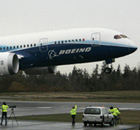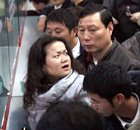Op-Ed Contributors
Ending long history of hukou
By Yao Yang (China Daily)
Updated: 2009-12-16 07:46
 |
Large Medium Small |
This year's Central Economic Work Conference could be historic. If its decision were effectively implemented, the half-century-old hukou system could be history. Set up in 1958 as part of the communization drive, the hukou - or residential registration system - has prevented rural residents from migrating freely to cities. In the official statement released after the meeting, the central authorities pledged to "push for urbanization in an active and steady manner" and to "solve the hukou problem of migrant workers". In an official conference held immediately after the central authorities' meeting, the National Development and Reform Commission (NDRC) announced a plan to study and form a policy next year for migrant workers' hukou.
It is interesting to observe this change amidst the current global financial crisis. The hukou system has long been criticized for its pervasive negative effects on people's welfare and economic efficiency, but has nevertheless remained intact except for sporadic and partial reforms. Then, why the change today?
|
||||
Urbanization is one of the structural adjustments aimed at reducing China's reliance on external demand. China's rate of urbanization lags behind other countries with similar levels of income. Including the 140 million rural migrants living in the city without urban hukou, China has 46 percent of its population living in cities whereas the world average is above 50 percent. If the 140 million rural migrants were granted urban hukou, domestic consumption would substantially increase for several reasons.
A direct effect of accelerated urbanization is that the current migrants will increase spending. Many of them come to cities alone, leaving their families back in the village. They stay in company-provided dormitories and have company-provided meals so their spending is limited. Giving them hukou will allow them to have longer time horizons in the city so that they can bring their families with them. If half of the migrantsbrought one more family member each to the city, China's urbanization rate would rise above the global average. This would significantly increase domestic consumption. Currently, an average urban resident consumes 1.6 times more than his rural counterpart. If the 140 million migrants and their newly-added 70 million family members raised their consumption to the urban level, China's domestic consumption would increase by 16 percent, which would make up for the loss of external demand in 2009.
But that is not the end of the story. A faster pace of urbanization would also increase the demand for services, infrastructure and housing, which may create extra benefits in addition to increasing domestic demand. One of those benefits is an increase in the share of household income. In the last decade, the share of household income in national income dropped by 16 percentage points, a significant reason for the slow growth of domestic consumption. One of the causes for this dramatic drop has been capital concentration in the Chinese economy, which is primarily caused by the slow growth of the service sector dominated by small- and medium-sized enterprises and hires more workers than the manufacturing units. Urbanization will lead to the expansion of the service sector and ultimately increase household income. Another extra benefit is the increase in domestic investment. Many people believe that external imbalances are the major contributor to China's burgeoning official foreign reserves, but the other side of the story is that domestic investment has not caught up with the growth of domestic savings. A faster pace of urbanization increases domestic investment and thus eases China's external imbalances.
To be sure, the hukou problem will not be solved overnight. The NDRC has only pledged to study the problem; concrete policies are still awaited. A complete abolition of the hukou system is highly unlikely in the short run. Migrants may need to provide proof of continuous residency in a city plus stable income and rental housing to get urban hukou, and large cities may have more restrictive policies than small- and medium-sized cities. The key, however, is the motion of change has set off and the country is on the track rolling toward the end of a piece of history.
The author is associated with the China Center for Economic Research & National School of Development under Peking University.
(China Daily 12/16/2009 page8)













